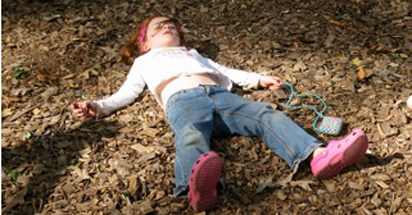What children will actually do...dramatic play
“We’re cooking the babies!” they shouted gleefully. They were jumping up and down around a pretend campfire of dried and crumpled leaves. All the outdoor baby dolls were piled on top. This was from before I had access to a digital camera and the luxury of documenting the children’s play like we do now. Without this documentation, dear readers, you will have to imagine this…this snapshot of play, separated from any adult misgivings, held true to every bit of definition and the benefits dramatic play offers children.
This event was child-sourced, language-led, rich with expression and vocabulary, imagination, creative problem solving, cooperation, even math and science, because that is what dramatic play shapes for children. I can also assure you that the children engaged in this particular play arc have not grown up to be mean to babies or cruel to other children or adults. Quite the opposite. These particular children are now young teenagers and are lovely, caring citizens of the world.
See here is the thing...For every dramatic play arc that features comfortable scenarios, and each of us has a set that feels “just right,” there are others filled with wild rides, fantastical beasts, scary people, and are shock-pot full of bones and blood. I have documented all kinds. This is what children will actually do and it does not reveal some hidden agenda or deep-seated fears. Just as deconstructing with loose parts is very much part of learning how to construct (discussed in an early post, What children will actually do...), being able to freely explore child-sourced dramatic play arcs will bring children closer to independently connecting with each other and solving their own problems.
In order to sustain the play of their choice, we look for the hallmarks of cooperative, rule-governed dramatic play. If it is not there, the systems check makes room for developmental age and then we talk about it or provide the support without removing the theme/focus of the play. To find an example of what I call flat-line play, imagine this scenario—small world, dinosaurs. A child picks up a dino and stomps it around on the ground and in the air, roaring. This is imaginary play that we would expect from a very young child at our school (2 and just 3). We would scaffold this play by pulling out other materials and loose parts to create the world this stomping, snapping dinosaur inhabits. With younger children, we would model the language consistent with this play, trying not to dilute the original idea (stomping/biting) just simply enriching it. For instance, "The dinosaur is so giant that these stones are tiny next to it and it makes a nest from them" or "This dinosaur is carrying his eggs to his nest. He has to hide his nest from the other dinosaurs." An even better one is to acknowledge that the dinosaur is big and needs to eat, a lot, "These stones are delicious and chompy. The dinosaur has to hunt these down for sure." The children will move from solitary play through to parallel play and on to cooperative play using this model of support.
Last year, I attended a conference session on the importance of dramatic play in early childhood. As an example of dramatic play, the presenters included photos of children recreating the story the three little pigs. This is a story sourced by the teachers although it was being presented as an example of dramatic play and the importance of child-sourced dramatic play. I have never seen children re-enact a story line like that without the direct influence of an adult. Children will fold in elements of story, certainly, but they will not follow a story line whole from beginning to end left to their own devices.
Listening to those gathered afterward, I worried that the message given and received was that true dramatic play, sourced by the children, would be unwieldy and hard to control. I can tell you that we have A LOT of meetings with children to discuss and review their dramatic play. This takes time and attention and the willingness to hold discussions about ideas like the design and use of things like cannon arms that shoot and soul-sucking vacuum hoses that take souls out of bodies, cleans them in a fish tank and returns them, smaller, but very, very clean (two examples of child-inventions we have seen just this month!). This is why these presenters may have decided to show and discuss only supported, controlled dramatic play. In the meantime, that very thing runs contrary to what their research and the research of others supports.
Play can get messy, very, very messy. And loud. And rambunctious. Does that suit every setting? Every adult?
If we want to create the platform for truly child-sourced and creative dramatic play, then we also have to be ready for dead princesses, parents who have left their children home alone while they are off adventuring in New York City, along with pretend broken bones, multiple and unnecessary shots, etc. We cannot limit their play to things prettified and palatable. It is another form of risky play -- in this case, with ideas rather than physical risk. Are we ready for it?
This is what children will actually do . . .





